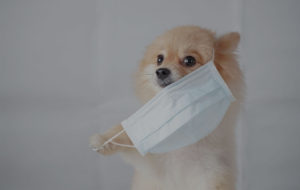What causes COVID-19?
 Coronaviruses (CoV) are a family of RNA (ribonucleic acid) viruses. They are called coronaviruses because the virus particle exhibits a characteristic ‘corona’ (crown) of spike proteins around its lipid envelope. CoV infections are common in animals and humans. Some strains of CoV are zoonotic, meaning they can be transmitted between animals and humans, but many strains are not zoonotic.
Coronaviruses (CoV) are a family of RNA (ribonucleic acid) viruses. They are called coronaviruses because the virus particle exhibits a characteristic ‘corona’ (crown) of spike proteins around its lipid envelope. CoV infections are common in animals and humans. Some strains of CoV are zoonotic, meaning they can be transmitted between animals and humans, but many strains are not zoonotic.
In humans, CoV can cause illness ranging from the common cold to more severe diseases such as Middle East Respiratory Syndrome (caused by MERS-CoV), and Severe Acute Respiratory Syndrome (caused by SARS-CoV). Detailed investigations have demonstrated that SARS-CoV was transmitted from civets to humans, and MERS-CoV from dromedary camels to humans.
In December 2019, human cases of pneumonia of unknown origin were reported in Wuhan City, Hubei Province of China (People’s Rep. of). A new CoV was identified as the causative agent by Chinese Authorities. Since then, human cases, most of them with travel history to Wuhan or Hubei region, have been reported by several provinces in China (People’s Rep. of) and by a number of other countries. For up to date information please consult the WHO website.
The CoV which causes COVID-19 has been designated as SARS-CoV-2 by the International Committee on Taxonomy of Viruses (ICTV); this is the scientific name. The virus may also be referred to as “the COVID-19 virus” or “the virus responsible for COVID-19”. COVID19 refers to the disease caused by the virus.
Are animals responsible for COVID-19 in people?
The predominant route of transmission of COVID-19 appears to be from human to human.
Current evidence suggests that the COVID-19 virus has an animal source. Ongoing investigations are important for identifying the animal source (including species involved) and establishing the potential role of an animal reservoir in this disease. Yet, to date, there is not enough scientific evidence to identify that source or to explain the route of transmission from an animal source to humans. Genetic sequence data reveals that the COVID-19 virus is a close relative of other CoV found circulating in Rhinolophus bat (Horseshoe Bat) populations. There is the possibility that transmission to humans involved an intermediate host.
Priorities for research to investigate the animal source were discussed by the OIE informal advisory group on COVID-19 and were presented at the WHO Global Research and Innovation Forum (11-12 February 2020) by the President of the OIE Wildlife Working Group. The outcomes from the discussion of the OIE informal advisory group on COVID-19 can be found at the link.
Are there any precautions to take with live animals or animal products?
Although there is uncertainty about the origin of the COVID-19 virus, in accordance with advice offered by the WHO, as a general precaution, when visiting live animal markets, wet markets or animal product markets, general hygiene measures should be applied. These include regular hand washing with soap and potable water after touching animals and animal products, as well as avoiding touching eyes, nose or mouth, and avoiding contact with sick animals or spoiled animal products. Any contact with other animals possibly living in the market (e.g., stray cats and dogs, rodents, birds, bats) should be avoided. Precaution should be taken to avoid contact with animal waste or fluids on the soil or surfaces of shops and market facilities.
Standard recommendations issued by WHO to prevent infection spread include regular hand washing, covering mouth and nose with the elbow when coughing and sneezing and avoiding close contact with anyone showing symptoms of respiratory illness such as coughing and sneezing. As per general good food safety practices, raw meat, milk or animal organs should be handled with care, to avoid potential cross-contamination with uncooked foods. Meat from healthy livestock that is cooked thoroughly remains safe to eat. Further recommendations from WHO can be consulted here.
Based on currently available information, trade restrictions are not recommended.
What do we know about COVID-19 virus and companion animals?
The current spread of COVID-19 is a result of human to human transmission. To date, there is no evidence that companion animals can spread the disease. Therefore, there is no justification in taking measures against companion animals which may compromise their welfare.
The Veterinary Services of the Hong Kong Special Administrative Region of the People’s Republic of China reported to OIE evidence that a dog had tested positive to the COVID-19 virus following close exposure to its owners who were sick with COVID-19 – see Immediate Notification (01/03/2020) and Follow-up report no.1 (09/03/2020). The test, conducted by real time PCR, showed the presence of genetic material from the COVID-19 virus. The dog was not showing any clinical signs of the disease. There is no evidence that dogs play a role in the spread of this human disease or that they become sick. Further studies are needed to understand if and how different
animals could be affected by COVID-19 virus. The OIE will continue to provide updates as new information becomes available.
There is no evidence to support restrictions to movement or trade of companion animals.
What precautionary measures should be taken by owners when companion or other animals have close contact with humans sick or suspected with COVID-19?
There have not been any reports of companion or other animals becoming sick with COVID-19 and currently there is no evidence that they play a significant epidemiological role in this human disease. However, because animals and people can sometimes share diseases (known as zoonotic diseases), it is still recommended that people who are sick with COVID-19 limit contact with companion and other animals until more information is known about the virus.
When handling and caring for animals, basic hygiene measures should always be implemented. This includes hand washing before and after being around or handling animals, their food, or supplies, as well as avoiding kissing, licking or sharing food. When possible, people who are sick or under medical attention for COVID-19 should avoid close contact with their pets and have another member of their household care for their animals. If they must look after their pet, they should maintain good hygiene practices and wear a face mask if possible
- Know How it Spreads
There is currently no vaccine to prevent coronavirus disease 2019 (COVID-19). - The best way to prevent illness is to avoid being exposed to this virus.
- The virus is thought to spread mainly from person-to-person.
- Between people who are in close contact with one another (within about 6 feet).
- Through respiratory droplets produced when an infected person coughs or sneezes.
- These droplets can land in the mouths or noses of people who are nearby or possibly be inhaled into the lungs.
In December 2019, human cases of pneumonia of unknown origin were reported in Wuhan City, Hubei Province of China (People’s Rep. of). A new CoV was identified as the causative agent by Chinese Authorities. Since then, human cases, most of them with travel history to Wuhan or Hubei region, have been reported by several provinces in China (People’s Rep. of) and by a number of other countries. For up to date information please consult the WHO website.
The CoV which causes COVID-19 has been designated as SARS-CoV-2 by the International Committee on Taxonomy of Viruses (ICTV); this is the scientific name. The virus may also be referred to as “the COVID-19 virus” or “the virus responsible for COVID-19”. COVID19 refers to the disease caused by the virus.
Take steps to protect yourself
- Clean your hands often
- Wash your hands often with soap and water for at least 20 seconds especially after you have been in a public place, or after blowing your nose, coughing, or sneezing.
- If soap and water are not readily available, use a hand sanitizer that contains at least 60% alcohol. Cover all surfaces of your hands and rub them together until they feel dry.
- Avoid touching your eyes, nose, and mouth with unwashed hands.
- Avoid close contact
- Avoid close contact with people who are sick
- Put distance between yourself and other people if COVID-19 is spreading in your community. This is especially important for people who are at higher risk of getting very sick.
- Take steps to protect others
- Stay home if you are sick, except to get medical care. Learn what to do if you are sick.
- Cover your mouth and nose with a tissue when you cough or sneeze or use the inside of your elbow.
- Throw used tissues in the trash.
- Immediately wash your hands with soap and water for at least 20 seconds. If soap and water are not readily available, clean your hands with a hand sanitizer that contains at least 60% alcohol.
- Wear a facemask if you are sick
- If you are sick: You should wear a facemask when you are around other people (e.g., sharing a room or vehicle) and before you enter a healthcare provider’s office. If you are not able to wear a facemask (for example, because it causes trouble breathing), then you should do your best to cover your coughs and sneezes, and people who are caring for you should wear a facemask if they enter your room. Learn what to do if you are sick.
- If you are NOT sick: You do not need to wear a facemask unless you are caring for someone who is sick (and they are not able to wear a facemask). Facemasks may be in short supply and they should be saved for caregivers.
- Clean and disinfect
- Clean AND disinfect frequently touched surfaces daily. This includes tables, doorknobs, light switches, countertops, handles, desks, phones, keyboards, toilets, faucets, and sinks.
- If surfaces are dirty, clean them: Use detergent or soap and water prior to disinfection.
- To disinfect: Most common EPA-registered household disinfectants will work. Use disinfectants appropriate for the surface.
Options include:
- Diluting your household bleach.
- 5 tablespoons (1/3rd cup) bleach per gallon of water To make a bleach solution, mix: Follow manufacturer’s instructions for application and proper ventilation. Check to ensure the product is not past its expiration date. Never mix household bleach with ammonia or any other cleanser. Unexpired household bleach will be effective against coronaviruses when properly diluted.
4 teaspoons bleach per quart of water - Alcohol solutions.
- Ensure solution has at least 70% alcohol.
- Other common EPA-registered household disinfectants
- Products with EPA-approved emerging viral pathogens pdf icon[7 pages]external icon claims are expected to be effective against COVID-19 based on data for harder to kill viruses. Follow the manufacturer’s instructions for all cleaning and disinfection products (e.g., concentration, application method and contact time, etc.).
See the following link to Complete disinfection guidance
